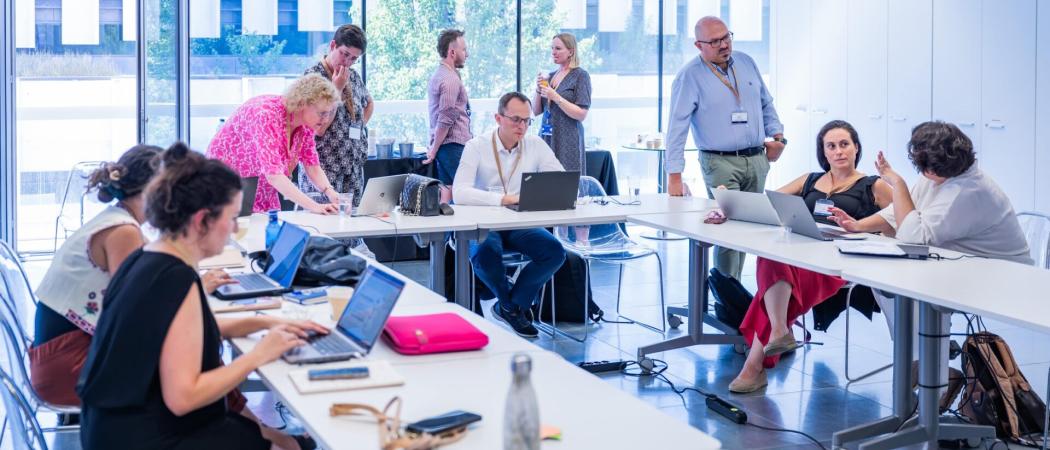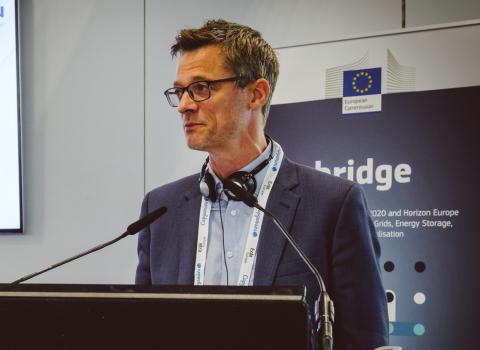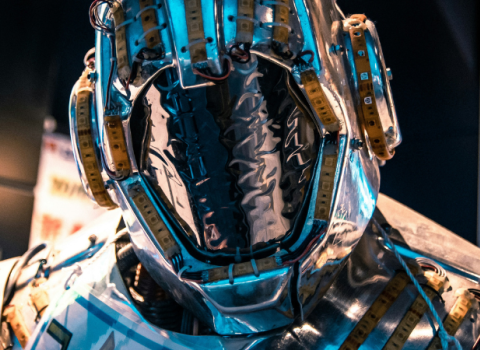Answer: You might just find which innovation policies work, and which don’t, say researchers in the EU-funded ATTRACT deep-tech project

Social scientists at a 2024 ESADE workshop on the ATTRACT project. Photo credits: ATTRACT.
Around the world, governments spend billions of euros a year to get new discoveries out of the lab and into the market. But do they actually know what works, and what doesn’t?
Spoiler alert: not really. In many cases, the design of R&D support programmes is just a matter of “well-intentioned guesswork,” says Albert Bravo-Biosca, director of the London- and Barcelona-based Innovation Growth Lab, a non-profit that studies innovation policy.
Moving beyond guesswork is the objective of an unusual group of social and economic studies supported by the EU-funded ATTRACT project. Coordinated by ESADE Business School in Barcelona, eight teams of social scientists across Europe have been taking a close look at scores of ATTRACT-supported R&D projects developing “deep-tech” innovations - for new kinds of sensors, monitors, materials and more. The aim: to study the project teams as little experiments in how to turn ideas into value, and to conclude from that what kinds of policies work best.
Normally, government R&D programmes get designed with what Bravo-Biosca calls “the hope strategy. You hope it is going to work. We’re trying to replace that with a more scientific test-and-learn strategy – to see what’s actually working.” As one of the researchers involved in the studies, he hopes the result will be better programme design – an important goal for the EU, in the midst of planning its next, multi-year Framework Programme for research, development and innovation.
‘Big science’ for enterprise
These studies are part of ATTRACT, a €55 million Horizon 2020 initiative to advance technologies emerging from Europe’s “big science” community – research
infrastructure like particle accelerators, scientific databases or synchrotrons. The project began in 2018 under leadership of the CERN particle-accelerator, and distributed seed money to 170 scientific teams across Europe. Then, it doubled-down on the money for 18 of the most successful projects. It also added an entrepreneurship-training programme for more than 1,000 young innovators. ATTRACT’s final conference takes place 2-3 July in Brussels.
Critically important for ATTRACT was a decision to set aside €1 million for socioeconomic research on its R&D projects – observing how they work, and what could make them work better. “Our idea is to do some fairly rigorous studies that show how investments in infrastructure (and related technologies) can be optimised,” says Jonathan Wareham, an ESADE professor who coordinated the effort.
That approach is very rare in R&D funding anywhere in the world; usually, big public funders pump the money across hundreds or thousands of individual projects in a hit-or-miss strategy. One immediate problem with that, Wareham notes: how do you even decide what’s a successful project? Most commonly, policy makers look at numbers: patents, published papers, jobs, sales. While those are important, there’s a broad range of other outcomes that need consideration, too, such as developing new talent, improving society or the environment, or creating new ecosystems from which other entrepreneurs benefit.
The results so far
Among the conclusions to date, says Wareham, is that it’s “wasted energy” to try training scientists to become entrepreneurs. In fact, of the project scientists who were studied, a “striking pattern” was that despite their entrepreneurial intentions they still “remained focused on traditional academic outputs,” according to an ATTRACT paper summarising the socioeconomic research. Instead, it’s better to pair the techies with people with other skills, such as marketing, finance, sales channels or management. Further, even if they wanted to go commercial, the scientists often lacked self-confidence in business.
Concludes Wareham: “You should keep the specialisation of labour; it’s good to find actors with complementary skill sets.”
A related point: diversity – in background, gender and outlook – is also good for an R&D project, as is “psychological flexibility” or an ability to adapt to new challenges and ideas. Training, they found, can promote that. Of the people who participated in a special behavioural training programme the researchers developed, more than 65% showed more flexibility afterwards. That means they were better able to engage with industry, more willing to collaborate, and more open to sharing ideas.
Overall, the researchers found, what’s needed is “a redesign of entrepreneurship education.” For instance, Wareham says, conventional business-school training focuses on consumer-facing entrepreneurship or raising capital: in short, how to create little Facebooks. That won’t make little Zuckerbergs out of young engineers or marketing students. Instead, they need exposure to each others’ worlds – the objective of ATTRACT’s separate Academy programme that has trained more than 1,000 students, from all disciplines and nationalities, on tech teamwork.
Clearing the hurdles
That kind of flexibility is needed to overcome the many obstacles a tech team will encounter. For instance, the researchers found, project teams encountered “widespread ambiguity” in the way seemingly straightforward EU laws or regulations are implemented nationally – a problem for any young business with ambition. Especially difficult: confusion about intellectual property law. More than 90% of the ATTRACT teams developed new IP, but only a fourth successfully licensed it. “The EU and its member states need to work to improve the consistency of laws and definitions,” the researchers concluded.
Another suggestion from the studies: research infrastructure can have all kinds of planned, and unplanned, benefits for innovation.
One of the eight studies focused on a collaboration between the European Molecular Biology Laboratory and AlphaFold, an artificial intelligence system from Google’s DeepMind whose inventors shared the Nobel Prize in chemistry last year. On the surface, the system can predict how a particular chemical sequence might fold itself into a functioning protein – a huge part of how biology works. But, by analysing scientific publications based on the system, they found two distinct communities at work: the AI or protein experts working directly with the DeepMind product, and a more diverse group working with the public EMBL database – on unexpected applications. That suggests lots of specialised, and valuable, networks are being formed to advance the protein work into new territory.
As Wareham sees it, the EMBL database was originally designed as a “one-trick pony”: to predict very specific protein configurations. In fact, he says, “the scientific community is using it like a Swiss Army knife,” for lots of serendipitous purposes.
Controlled experiments
These and other findings from the group are just the start of a more ambitious socioeconomic research programme they have in mind.
One of the eight projects has mapped out how to apply rigorous experimentation to tech entrepreneurship, evaluating business support or training programmes like a controlled experiment in a pharmaceutical trial. Called “Experimenting in University-Industry Collaboration”, the document diagrammes 22 different types of “interventions” that could be tested out to accelerate science commercialisation – such as increasing incentives for commercialising science or building new relationships between researchers and businesses.
In tech entrepreneurship, says Sara Garcia Arteagoitia, a senior researcher at the Innovation Growth Lab, “we’re trying to remove the policy guesswork.”





 A unique international forum for public research organisations and companies to connect their external engagement with strategic interests around their R&D system.
A unique international forum for public research organisations and companies to connect their external engagement with strategic interests around their R&D system.